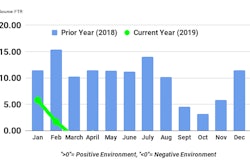Several facets of the trucking industry, from components to shipping, appear to have dodged a bullet June 7 when President Donald Trump decided to suspend a new tariff on all goods from Mexico. The 5 percent tariff was set to go into effect yesterday.
Trump announced on May 30 he would impose the tariff on all goods imported from Mexico if the country didn’t take action to stop the flow of migrants across the Mexico-U.S. border. The tariffs would have gone up an additional 5 percent each month to 25 percent in October or until the administration was satisfied with Mexico’s efforts.
The Motor & Equipment Manufacturers Association (MEMA), parent organization of the Heavy Duty Manufacturers Association, issued a statement Monday in favor of Trump’s decision.
“[MEMA] applauds President Trump’s decision to not impose tariffs on all goods coming from Mexico into the United States. We are pleased that he heard the motor vehicle parts supplier industry, which represents the largest sector of manufacturing jobs in the U.S., and that he agreed that tariffs would hurt American businesses and consumers,” MEMA states.
The importance of the immigration deal with Mexico, outlined in a joint agreement released by U.S. State Department officials on June 7, is underscored by some statistics provided by MEMA and FTR.
“Our industry depends on a vibrant and healthy North American supply chain, and Mexico is a critical trading partner. In 2018, two-way trade with Mexico in auto parts totaled $93 billion, or $255 million worth of goods a day. It is critical that confidence and stability in this supply chain remain in place,” MEMA says.
FTR released its own analysis last week of the trade relationship between Mexico and the U.S.
Although the U.S. goods trade deficit with Mexico is about $80 billion, the U.S. has held a longstanding trade surplus with Mexico in terms of rail tonnage and a growing truck tonnage surplus over the past three years, according to FTR’s Freight•cast forecasting model.
FTR estimates truck loads into and out of Mexico make up just 1.5 percent of all U.S. truck loadings, but that share has risen by about 50 percent since 2009.
While the share of overall truck volume dedicated to Mexico is small, FTR adds a significant piece of that are parts for vehicles, computers and machinery. “If the trucking freight went away, that in itself would not be a death knell for trucking, but the broader issue is the exponential impact on U.S. manufacturing,” said Eric Starks, FTR chairman and CEO.
The last time I wrote a blog about Trump and tariffs, it was about the president addressing foreign trade imbalance around the world and how his approach had created a sense of uncertainty within the industry. MEMA, an aftermarket distributor and an OEM said the uncertainty around trade would not only hurt business in the future, but already had begun to affect companies in our industry.
There was, however, a show of support for the president and his tariff strategy in the blog comments.
“So are you saying that the U.S. should just continue to be taken advantage of in certain aspects and not make an attempt to correct the ‘bad deals’ that supposedly have been made in the past?” asked one reader.
“It is because of the past leadership … that has put us in the spot we are in now. This president loves this country and is trying to bring it back to what it used to be,” commented another reader.
This latest matter with using tariffs to get Mexico to put forth more effort in stopping migrants from entering the U.S. is obviously a different animal. Trump isn’t looking to square up a trade imbalance; he’s using tariffs as a cudgel to get some cooperation from a longtime and significant trading partner.
Regardless of one’s opinions on immigration, should the president be using tariffs as leverage for matters other than trade at the possible expense of American businesses? What say you? Feel free to leave your comments below.










